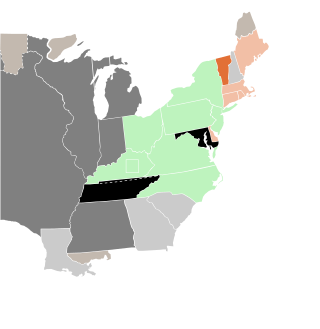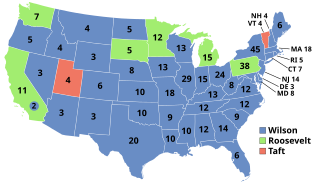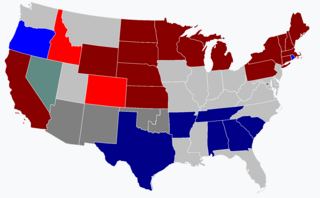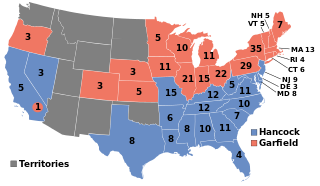Related Research Articles

The 1814–15 United States Senate elections were elections that had the Democratic-Republican Party lose a seat but still retain an overwhelming majority in the United States Senate. Unlike in recent elections, the minority Federalists had gone into the elections with a chance of regaining their long-lost majority had they swept almost all the seats. However, only one seat switched parties. Two seats held by Democratic-Republicans were left unfilled until long after the next Congress began.

The 1912 United States elections elected the members of the 63rd United States Congress, occurring during the Fourth Party System. Amidst a division between incumbent Republican President William Howard Taft and former Republican President Theodore Roosevelt, the Democratic Party won the Presidency and both chambers of Congress, the first time they accomplished that feat since the 1892 election.

The 1902 United States elections elected the 58th United States Congress, and occurred in the middle of Republican President Theodore Roosevelt's first term, during the Fourth Party System. Roosevelt had become president on September 14, 1901, upon the assassination of his predecessor, William McKinley. Republicans retained a majority in both chambers of Congress, while the Populist Party and Silver Republican Party disappeared from Congress.

The 1880 United States elections occurred during the Third Party System, and elected the members of the 47th United States Congress. Republicans retained the Presidency and took control of the House. An unclear partisan situation prevailed in the Senate. As the first presidential election after the end of Reconstruction, this election saw the first occurrence of the Democratic Party sweeping the Southern United States; the party would carry an overwhelming majority of Southern states well into the 20th century.

The 1856 United States elections elected the members of the 35th United States Congress and the President to serve from 1857 until 1861. The elections took place during a major national debate over slavery, with the issue of "Bleeding Kansas" taking center stage. Along with the 1854 elections, these elections occurred during the transitional period immediately preceding the Third Party System. Old party lines were broken; new party alignments along sectional lines were in the process of formation. The Republican Party absorbed the Northern anti-slavery representatives who had been elected in 1854 under the "Opposition Party" ticket as the second-most powerful party in Congress. Minnesota and Oregon joined the union before the next election, and elected their respective Congressional delegations to the 35th Congress.

The 1820 United States elections elected the members of the 17th United States Congress. The election took place during Era of Good Feelings and the First Party System. Despite the Panic of 1819, the Democratic-Republican Party maintained control of the presidency and both houses of Congress, while the Federalist Party provided only limited opposition. Missouri joined the union during the 17th Congress.

The 1816 United States elections elected the members of the 15th United States Congress. Mississippi and Illinois were admitted as states during the 15th Congress. The election took place during the First Party System. The Democratic-Republican Party controlled the Presidency and both houses of Congress, while the Federalist Party provided only limited opposition. The election marked the start of the Era of Good Feelings, as the Federalist Party became nearly irrelevant in national politics after the War of 1812 and the Hartford Convention.

The 1808 United States elections elected the members of the 11th United States Congress. The election took place during the First Party System. In the aftermath of the Embargo of 1807, the Federalists picked up Congressional seats for the first time since their defeat in the 1800 election. However, the Democratic-Republican Party maintained control of the Presidency and both houses of Congress.

The 1804 United States elections elected the members of the 9th United States Congress. The election took place during the First Party System. The Democratic-Republican Party continued its control of the Presidency and both houses of Congress.

The 1800 United States elections elected the members of the 7th United States Congress. The election took place during the First Party System, and is generally considered the first realigning election in American history. It was the first peaceful transfer of power between parties in American history. The Democratic-Republican Party won control of the Presidency and both houses of Congress for the first time. Conversely, the Federalist Party would never again control the Presidency or either house of Congress. Ohio was admitted as a state during the 7th Congress.

The 1796 United States elections elected the members of the 5th United States Congress. The election took place during the beginning stages of the First Party System, as the Federalist Party and the Democratic-Republican Party clashed over the states' rights, the financial policies of Treasury Secretary Alexander Hamilton, and the recently ratified Jay Treaty. The Federalists maintained control of the Senate, and won control of the House and the presidency.
The 1794 United States elections occurred in the middle of President George Washington's second term. Members of the 4th United States Congress were chosen in this election. Tennessee was admitted as a state during the 4th Congress. The election took place at the beginning of the First Party System, with the Democratic-Republican Party and Federalist Party emerging as political parties, succeeding the anti-administration faction and the pro-administration faction.
The 1802 United States elections occurred in the middle of Democratic-Republican President Thomas Jefferson's first term, during the First Party System. Members of the 8th United States Congress were chosen in this election. Democratic-Republicans picked up several seats in both chambers of Congress, solidifying their control over the House and Senate.
The 1810 United States elections occurred in the middle of Democratic-Republican President James Madison's first term, during the First Party System. Members of the 12th United States Congress were chosen in this election. During the 12th Congress, Louisiana joined the union. Democratic-Republicans continued to control both chambers of Congress.
The 1818 United States elections occurred in the middle of Democratic-Republican President James Monroe's first term, during the First Party System and the Era of Good Feelings. Members of the 16th United States Congress were chosen in this election. During the 16th Congress, Alabama and Maine joined the union. Democratic-Republicans continued to dominate both chambers of Congress, and slightly increased their majority in both houses of Congress in this election.
The 1822 United States elections occurred in the middle of Democratic-Republican President James Monroe's second term, and was the last election of the First Party System. Members of the 18th United States Congress were chosen in this election. The 1820 census added 26 seats to the House. Democratic-Republicans continued to dominate both chambers of Congress.

The 1858 United States elections occurred in the middle of Democratic President James Buchanan's term and marked the end of the transitional period between the Second Party System and the Third Party System. Members of the 36th United States Congress were chosen in this election. In the first election since the Supreme Court decided Dred Scott v. Sandford, the Republican Party won a plurality in the House, taking control of a chamber of Congress for the first time in the party's history. Although Democrats lost control of the House, they retained their majority in the Senate.

The 1866 United States elections occurred in the middle of National Union/Democratic President Andrew Johnson's term, during the Third Party System and Reconstruction. Johnson had become president on April 15, 1865, upon the death of his predecessor, Abraham Lincoln. Members of the 40th United States Congress were chosen in this election. As this was the first election after the Civil War, many ex-Confederates were barred from voting, and several Southern states did not take part in the election. Delegations from Arkansas, Florida, Alabama, North Carolina, Louisiana, and South Carolina were re-admitted during the 40th Congress.

The 1874 United States elections occurred in the middle of Republican President Ulysses S. Grant's second term, during the Third Party System. Members of the 44th United States Congress were chosen in this election. The election took place during the Reconstruction Era, and many Southerners were barred from voting. Colorado joined the union during the 44th Congress. Democrats took control of a chamber of Congress for the first time since the start of the Civil War, winning a huge number of seats from House Republicans. However, the Republicans retained a majority in the Senate. The election marked the first occurrence of the six-year itch phenomenon, in which a president's party lost many Congressional seats during the president's second mid-term election.

The 1886 United States elections occurred in the middle of Democratic President Grover Cleveland's term, during the Third Party System. Members of the 50th United States Congress were chosen in this election. Democrats retained control of the House, while Republicans retained control of the Senate.
References
- ↑ Not counting special elections.
- 1 2 Congressional seat gain figures only reflect the results of the regularly-scheduled elections, and do not take special elections into account.
- ↑ "Party Divisions of the House of Representatives". United States House of Representatives. Retrieved 25 June 2014.
- ↑ "Party Division in the Senate, 1789-Present". United States Senate. Retrieved 25 June 2014.